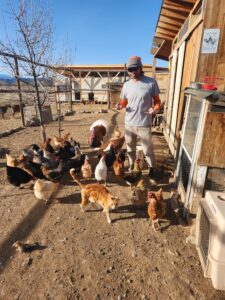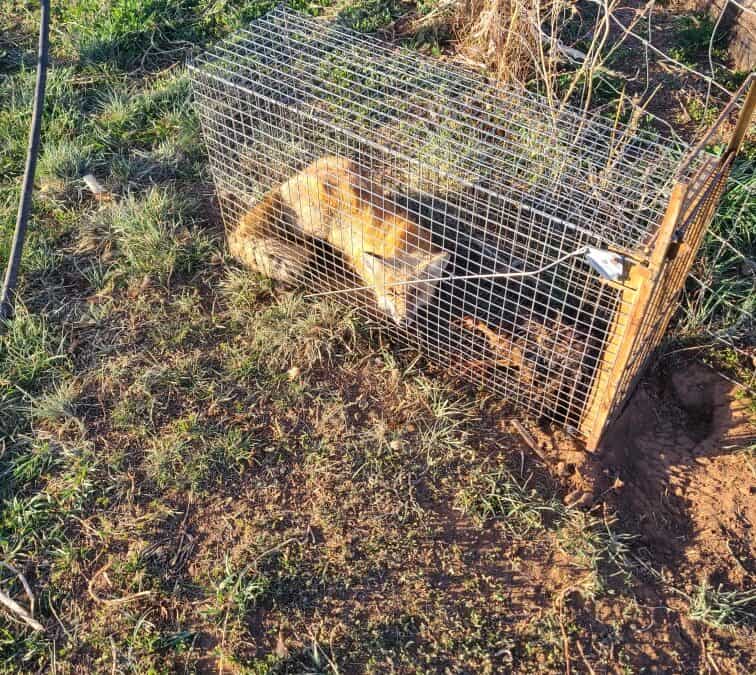This region is a place of self-reliance, and that’s how I got into this business. I spent years protecting my own chickens before I got into it professionally.

Feeding the chickens
When I would lose a chicken, I learned the difference between how skunks, foxes, and raccoons take them. I’ll spare you the details, but I know you can definitely trap nuisance wildlife on your own, and lots of people do here.
This post is to make sure you understand what that entails from start to finish.
1. Choose your trap size
Depending on what you’re trying to trap, you’ll need a certain size to be successful. Traps range in price from $50-$200, and you can buy them locally or from any online retailer and they usually have several in stock.
Wildlife Control Supplies has a great selection of traps available as well as a great guide for helping you select the right trap and size for your targeted animal.
2. Select your bait
Using the right bait is key to trapping the right animal. Sometimes it’s easy: for example, skunks and raccoons love cat food! However, so do your neighborhood cats. Fortunately, these are live traps (See CPW regulations here), so you can just release the cats. Unfortunately, cats are way less afraid of humans and therefore more likely to be caught. We’ll talk more about positioning traps to avoid cats in a minute.
Other baits can be bought online, but in general, raccoons like sweets and skunks like stinky leftover meat (so do other predators, so be careful here if you’re trying to keep them out of a chicken coop. I learned that the hard way).
3. Decide where to put your trap
Where do you put the trap? That is entirely dependent on the animal, but they are all food-driven. Keep in mind that some critters will literally have to walk out of their den into your trap and others will check it out if it’s set smack dab in the middle of where they’ve decided to call home. But don’t forget, so will the cats.
4. Determine if there is only one or multiples of your nuisance wildlife
You caught one! Now what? Determine if it was the only one or if “the site” is still active. Game cams or even any other home camera can help with this. If there are more, rinse and repeat (see above and below).
Once you verify that no other animal is occupying the site, you can move on to doing what professionals like me call, “Exclusion”. In this way you will ensure that you don’t end up accidentally trapping the animal away from food and ending up eliminating them in an inhumane way or with a terrible stink in the house. Verifying that the animals are all gone is very important, as you’ll see in this next step.
This is where a game cam can also be useful to make sure no other animals are present.
5. Seal up all potential entries to the site
Now you have to seal up all potential entries or other animals will find it, drawn by the smell of their predecessors. This is really, really important. Did you make sure there were no other live skunks spraying around in there? Good! Seal it up! And seal it up well… get hardware cloth, screws, screens, nails, rocks, boards, and other deterrents.
6. Relocating or dispatching the nuisance wildlife
Most importantly, when you catch the animal in your trap, what will you do with it? Colorado regulations say you can’t relocate it except on private land, with owner permission, within two miles of your property.
Sadly, if you find an appropriate place and choose to release it within a few miles of your home, it will try to come back, and if it can’t, it will struggle to find food and shelter and will likely die of starvation or from a larger predator.
On the other hand, you can dispatch and dispose of the animal yourself. At Animas Wildlife Solutions, we have safe and ethical practices we utilize to ensure the best possible outcome to euthanize and remove the animal and secure your property.
Final notes on trapping your own nuisance wildlife
Hopefully the information above helps you to decide what is best for you, your family, and your property. If you choose to have Animas Wildlife Solutions take care of the issue for you, we would love to hear from you. Click this link to be directed to our Request a Quote page so we can restore your peace of mind as soon as possible!

